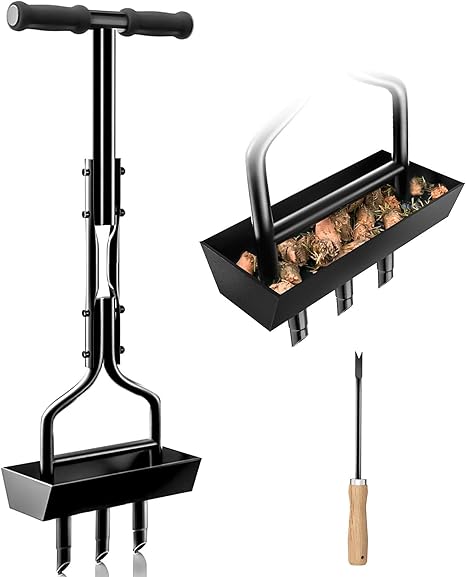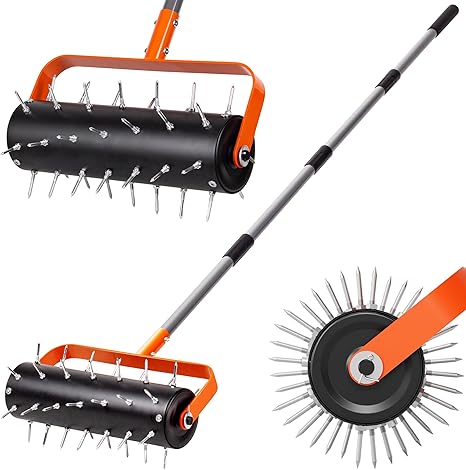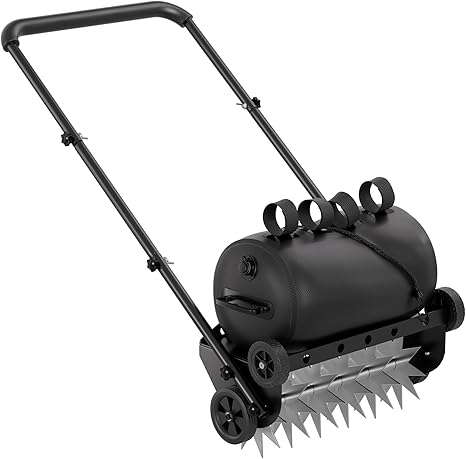Best Manual Lawn Aerators 2025 — Top Picks
Walensee Lawn Aerator Spike Metal Manual Review: Revitalize Your Lawn the Easy Way
If you’re searching for a practical, effective tool to breathe new life into your lawn, the Walensee Lawn Aerator Spike Metal Manual is worth considering. Designed with efficiency and durability in mind, this manual lawn aerator tackles soil compaction and thatch buildup, helping your grass thrive by improving airflow, water absorption, and nutrient penetration.

Key Features
- 15 Sharp Iron Spikes: Equipped with 15 sturdy spikes measuring 2.3 inches each, it efficiently aerates a larger area in less time compared to models with fewer spikes.
- Durable Iron Construction: Built from heavy-duty iron with a powder-coated finish, this aerator resists rust and lasts season after season.
- Ergonomic Design: Features a cushioned T-handle and foot bar for comfortable use, reducing strain during extended lawn care sessions.
- Easy Assembly and Portability: Comes partly assembled with clear instructions and simple hardware, allowing quick setup and easy transport after disassembly.
- Versatile Soil Compatibility: Works effectively on various soil types—clay, sand, or loam—to encourage a thicker and healthier lawn.
Pros and Cons
- Pros:
- Significantly improves lawn health by promoting root growth.
- Increases efficiency with 15 spikes working simultaneously.
- Sturdy build ensures long-lasting performance.
- Ergonomic handle design reduces user fatigue.
- Simple installation and easy to carry around.
- Cons:
- Manual operation requires physical effort, which may not suit everyone.
- Works best on moist soil—watering beforehand is recommended.
- No motorized option available for larger properties.
Performance & User Experience
The Walensee Lawn Aerator excels in everyday garden use. Users report noticeable improvements in soil condition and grass density after regular aeration sessions. The 15 sharp spikes penetrate compacted soil easily, especially when the ground is damp. The ergonomic T-handle and foot pedal provide solid leverage, making the task less strenuous than conventional spike shoes or smaller handheld aerators. Its robust metal construction holds up well under repeated use without bending or rusting.
Comparison
Compared to traditional spike shoes or plastic aerators, the Walensee Aerator offers a superior blend of durability and efficiency. While coring aerators like the YARDMAX 201cc Select provide deeper soil penetration, they are often bulkier and pricier. This manual spike aerator strikes a balance for homeowners who want effective aeration without investing in powered equipment.
Who Is This Product For?
This aerator is ideal for homeowners with small to medium-sized yards who want a cost-effective, reliable solution to improve lawn health naturally. Garden enthusiasts who prefer manual tools over gas-powered options will appreciate its straightforward design and sturdy construction. It’s also perfect for those looking to prepare their lawn for reseeding or simply maintain vibrant grass throughout the seasons.
Final Verdict
The Walensee Lawn Aerator Spike Metal Manual is a smart investment for anyone serious about lawn care. It combines efficiency, durability, and user-friendliness in one affordable package. While it requires a bit of elbow grease, the results—a healthier, thicker lawn—are well worth the effort. If you want to say goodbye to patchy, dry grass and welcome a lush, revitalized yard, this tool offers a practical path forward.
Manual Push Core Aerator Lawn Tool Review: A Must-Have for Healthy Lawns
If you’re serious about maintaining a lush, green lawn, aeration is key. The Manual Push Core Aerator Lawn Tool offers an efficient and durable solution to combat soil compaction and promote healthier grass growth. Designed with precision-engineered hollow tines, this tool helps your lawn breathe by allowing air, water, and nutrients to reach deep into the roots. Let’s dive into why this lawn aerator is worth considering for your yard care routine.

Key Features
- Professional-Grade Build: Made from industrial-strength steel with tempered hollow tines designed to resist bending and warping during repeated use.
- Three Replaceable Hollow Tines: Deep-drilling hollow tines extract compacted soil plugs, enhancing water drainage and nutrient absorption.
- Comfort-Grip Handle: Ergonomically designed handle reduces hand fatigue and lowers back strain, making lawn aeration more comfortable.
- Semi-Assembled & Quick Setup: Comes partially assembled with included tools, enabling easy and fast assembly so you can start aerating right away.
Pros and Cons
- Pros:
- Durable and built to last with high-quality steel construction
- Replaceable tines extend the tool’s lifespan
- Improves lawn health by reducing soil compaction effectively
- Comfortable design minimizes physical strain
- Easy to assemble and user-friendly for beginners
- Cons:
- Manual operation requires physical effort, not ideal for very large lawns
- May require pre-watering dry soil areas for best results
- No wheels or rolling mechanism to assist movement
Performance & User Experience
In practice, the Manual Push Core Aerator delivers consistent results across various soil types. The sharp hollow tines easily penetrate compacted ground, pulling out soil plugs without excessive force. Users report noticeable improvements in lawn texture and root health after regular use. The comfort-grip handle significantly reduces fatigue, allowing longer aeration sessions without discomfort. For optimal performance, watering your lawn 24 hours before aerating helps the tines glide through the soil. While manual effort is required, the tool’s solid construction makes it a reliable companion for weekend yard work.
Comparison with Similar Products
When compared to other manual lawn aerators on the market, such as spike-type tools, this core aerator outshines due to its hollow tine design which actually removes plugs rather than just poking holes. This leads to better soil aeration and improved water absorption. Although powered aerators can cover large areas faster, this manual tool offers excellent control, durability, and affordability, making it ideal for small to medium-sized lawns.
Who Is This Product For?
This lawn aerator is perfect for homeowners, gardening enthusiasts, and anyone looking to maintain a healthy, vibrant lawn without investing in expensive machines. It suits those with moderate-sized yards who don’t mind a bit of manual work in exchange for long-term lawn health benefits. If you want a reliable, professional-grade tool that lasts and improves turf quality, this is an excellent choice.
Final Verdict
The Manual Push Core Aerator Lawn Tool offers a robust and effective way to enhance your lawn’s health by tackling soil compaction head-on. Its durable construction, ease of use, and thoughtful ergonomic features make it a valuable addition to your gardening toolkit. While it requires physical effort, the benefits of healthier, greener grass are well worth it. If you’re committed to lawn care and want a practical, long-lasting aerator, this product deserves your attention.
Lawn Aerator Garden Tool with Soil Core Tray Review: Efficient Lawn Care Made Easy
Maintaining a lush, healthy lawn requires more than just watering and mowing — aeration plays a crucial role in promoting grass growth by improving soil health. The Lawn Aerator Garden Tool with Soil Core Tray is a manual solution designed to simplify this important task. With its unique soil collection tray, sturdy build, and sharp coring tines, this tool aims to make lawn care more efficient and less physically demanding. If you’re looking for a reliable way to combat soil compaction and revitalize your lawn, this vanpein aerator is worth a closer look.

Key Features
- Built-in Soil Core Tray: Collects soil plugs automatically as you aerate, eliminating the need to bend, rake, or brush soil from the lawn.
- Sharp Coring Tines: Three upgraded tines penetrate compacted soil easily, requiring less physical effort compared to hollow aerators.
- Heavy-Duty Construction: Crafted from 2mm thick iron with rust-proof full-body painting for durability and long-lasting performance.
- Ergonomic Design: 38-inch length with a flat foot base and padded handle offers comfortable use and effective soil penetration without straining your back.
- Bonus Cleaning Tool: Includes a manual cleaning stick for unclogging the core holes and light weeding, enhancing maintenance convenience.
Pros and Cons
- Pros:
- Efficient soil plug collection saves time and effort
- Sharp tines reduce the force needed to aerate tough soil
- Durable, rust-resistant iron construction
- Comfortable grip and ergonomic leverage design
- Easy assembly and includes useful cleaning tool
- Cons:
- Manual operation may be labor-intensive for very large lawns
- Best used on dry soil, so pre-watering may be necessary
Performance & User Experience
Users report that the soil core tray is a game-changer, allowing for cleaner and quicker aeration without the hassle of bending down to pick up soil plugs. The sharp tines penetrate compacted lawn areas with relative ease, even for users new to aerating. The tool’s ergonomic design minimizes back strain, making it suitable for homeowners who prefer a manual option over powered aerators. Additionally, the included cleaning stick helps maintain tine effectiveness, ensuring smooth operation over time. While manual effort is still required, this aerator streamlines the process considerably.
Comparison with Similar Products
Compared to hollow spike aerators, which can sometimes compress soil further, this plug aerator with sharp coring tines effectively removes soil plugs, improving oxygen and nutrient flow to grass roots. Unlike some manual aerators lacking soil collection trays, this model’s built-in tray enhances convenience and cleanliness, saving time during the yard work process.
Who Is This Product For?
This lawn aerator is ideal for homeowners with small to medium-sized lawns who want an affordable, eco-friendly way to improve lawn health. Gardeners concerned about soil compaction, those without access to power tools, or anyone seeking a durable manual aerator with time-saving features will find this tool particularly useful.
Final Verdict
The Lawn Aerator Garden Tool with Soil Core Tray is a thoughtfully designed manual aeration solution that combines practical features with durable construction. Its soil collection tray, sharp tines, and ergonomic design make lawn aeration less of a chore and more effective in promoting greener, healthier grass. While manual use may require some physical effort, its efficiency and convenience make it a worthwhile investment for dedicated lawn enthusiasts.
If you’re ready to give your lawn the care it deserves, Buy Now and start transforming your lawn today!
Walensee Rolling Lawn Aerator Review: A Heavy-Duty Tool for Lush, Healthy Lawns
If you’re looking to breathe new life into your lawn by tackling soil compaction and promoting root growth, the Walensee Rolling Lawn Aerator is a compelling option. This manual aeration tool boasts a durable design and innovative features that make lawn care easier and more effective. In this review, we’ll explore why this heavy-duty spike aerator deserves your attention, especially if you want a thick, green lawn without breaking a sweat.

Key Features
- 42 Heat-Treated Spike Tines: The aerator features 42 two-inch spikes arranged in a unique spiral pattern. This design ensures smooth rolling without vertical jumps, enhancing stability and efficiency during use.
- Durable Steel Construction: Made from premium steel, the roller is built to last. For deeper soil penetration, it can be filled with sand or stones, adding extra weight to tackle tougher soil.
- Adjustable Ergonomic Handle: The 71-inch handle breaks down into four parts and adjusts to your preferred height, reducing strain and improving comfort with a non-slip rubber grip.
- Easy Setup: Spikes come pre-installed, and all necessary tools plus extra cotter pins are included for quick and hassle-free assembly.
- Versatile Application: Suitable for various soil types, this aerator helps improve air, water, and nutrient flow to roots, encouraging a healthier lawn.
Pros and Cons
Pros:
- Robust steel build ensures long-term durability
- Spiral tine arrangement provides smooth, consistent aeration
- Adjustable handle enhances ergonomics for users of different heights
- Can be weighted for deeper soil penetration
- Pre-installed spikes simplify setup
- Excellent for decomposing thatch and improving lawn health
Cons:
- Manual operation may require moderate physical effort on large lawns
- Best results require moist soil, so pre-watering might be necessary
- Not motorized; slower than powered aerators for very extensive yards
Performance & User Experience
Users report that the Walensee Rolling Lawn Aerator efficiently penetrates compacted soil, allowing better air and nutrient absorption for grass roots. The spiral tine design reduces jolting and makes the aeration process smoother than many other manual rollers. Its adjustable handle and comfortable grip reduce fatigue during extended use. Adding sand or stones inside the roller increases its weight, promoting deeper spike penetration for tougher soil conditions. Overall, it’s a dependable tool that delivers visible improvements in lawn thickness and health after consistent use.
Comparison
Compared to similar manual aerators like the Yard Butler Lawn Aerator, the Walensee model stands out with its spiral tine pattern and weight-fillable roller, providing more stability and efficient soil penetration. While electric aerators such as the Greenworks Corded Aerator speed up the process, the Walensee unit offers an affordable, low-maintenance alternative ideal for smaller yards or gardeners preferring manual tools.
Who Is This Product For?
This aerator is perfect for homeowners with small to medium-sized lawns who want an easy-to-use, effective tool to improve soil health without investing in costly power equipment. Gardeners who prefer eco-friendly, manual lawn care will appreciate its sturdy build and ergonomic design. It’s also ideal for anyone dealing with compacted soil or thatch buildup seeking better water and nutrient flow to their grass roots.
Final Verdict
The Walensee Rolling Lawn Aerator delivers solid performance with a thoughtfully designed, durable frame and user-friendly features. Its ability to promote root growth and alleviate soil compaction makes it an excellent choice for achieving a lush, vibrant lawn. While it requires some manual effort, its ergonomic handle and smooth rolling action help reduce fatigue. For those committed to maintaining a healthy yard the natural way, this tool offers great value and reliability.
Buy Now and transform your lawn care routine today!
Landzie Hollow Tine Lawn Aerator Tool Review: The Ultimate Manual Lawn Care Solution
If you’re looking to transform your lawn from dull and compacted to lush and healthy, the Landzie Hollow Tine Lawn Aerator Tool is an excellent choice. This manual core aerator offers a practical, clog-free solution to soil compaction, helping your grass thrive by allowing air, water, and nutrients to penetrate deeper. In this review, we’ll explore why this tool stands out for both DIY lawn enthusiasts and landscaping professionals alike.

Key Features
- Revolutionary Beveled Hollow Tines: Designed to remove soil cores efficiently without clogging, thanks to the hollow and beveled stainless steel tines that push soil plugs out with every press.
- Durable Stainless Steel Construction: Made from powder-coated, heavy-duty steel that promises long-lasting use even in tough soil conditions.
- No Assembly Required: Ready to use right out of the box, with tines already fitted securely to the frame for immediate lawn care.
- Easy Maintenance: Tines can be easily removed for cleaning or replacement, keeping the aerator in optimal condition.
- Compatible with Other Landzie Lawn Tools: Works seamlessly when paired with Landzie’s compost spreader, peat moss spreader, and lawn leveling rake for comprehensive lawn revitalization.
Pros and Cons
- Pros:
- Efficient soil plug removal without clogging
- Robust and durable design built to last
- No setup or assembly needed
- Improves soil aeration, promoting healthy root growth
- Easy to clean and maintain
- Cons:
- Manual operation may require physical effort on larger lawns
- Not motorized, so less suitable for very large properties
Performance & User Experience
Users consistently praise the Landzie Hollow Tine Lawn Aerator for its smooth performance and clog-free operation. The stainless steel tines effectively penetrate compacted soil, pulling up plugs and allowing better air and water flow. Many lawn care enthusiasts report visible improvements in grass health after just one season of regular use. The tool’s ergonomic 42-inch handle provides good leverage, making the aeration process manageable even for those new to lawn care.
Comparison with Similar Products
Compared to other manual core aerators like the Agri-Fab 45-0299, which also offers hollow tines, the Landzie model distinguishes itself with its clog-free bevel design and sturdier steel construction. While some aerators may require frequent cleaning or get stuck with soil plugs, Landzie’s design minimizes these hassles, making your lawn work quicker and more efficient.
Who Is This Product For?
This lawn aerator is ideal for homeowners with small to medium-sized yards who want a cost-effective, eco-friendly way to improve their lawn’s health. It’s also well-suited for gardeners, landscapers, or lawn care professionals who prefer reliable manual tools without the maintenance demands of powered equipment. If you value durability and ease of use, the Landzie aerator fits perfectly into your toolkit.
Final Verdict
The Landzie Hollow Tine Lawn Aerator Tool offers a perfect balance of durability, efficiency, and user-friendly design. Its clog-free tines and sturdy build make aerating your lawn a straightforward task that can dramatically enhance soil health and grass vitality. Although it requires manual effort, the benefits far outweigh the physical work, especially for those committed to maintaining a lush, green yard. If you want a reliable, no-fuss aerator that gets the job done year after year, Landzie is a smart investment.
Suchtale 18-Inch Push Spike Aerator Review: A Heavy-Duty Solution for Lawn Care
Maintaining a healthy, lush lawn requires proper aeration to ensure water, nutrients, and air reach deep into the soil. The Suchtale 18-Inch Push Spike Aerator offers an effective, manual way to breathe new life into your yard without the noise or cost of powered equipment. Designed for durability and ease of use, this heavy-duty rolling lawn aerator promises to be a reliable companion in your gardening routine. Let’s explore why it stands out in the world of lawn aerators.
Key Features
- Unique 5-Star Shaped Spike Design: Equipped with five steel tine stars measuring 8 inches in diameter, each featuring 10 uneven spikes that penetrate compacted soil up to 2 inches deep. This design rotates independently, allowing better soil aeration and nutrient absorption.
- Robust Steel Construction: Made from strong steel tubes and sharp steel spikes, this aerator resists bending and rust, ensuring long-lasting performance on tough soil.
- Convenient Roller Design: Solid, flexible plastic rollers make pushing the aerator smooth and easy across various turf types, while its lightweight and compact build help navigate rough terrain without strain.
- Weight Tray for Enhanced Penetration: The built-in weight tray supports adding up to 16-inch bricks or cement blocks to boost spike penetration, making it versatile for different soil compactions.
- Durable Powder-Coated Finish: Protects the steel frame from rust and extends the aerator’s lifespan even when exposed to outdoor elements.
- Easy Assembly: Comes with a comprehensive instruction manual including pictorial guidance for quick and hassle-free setup.

Pros and Cons
- Pros:
- Efficient soil penetration with unique star-shaped spikes
- Rust-resistant steel construction ensures durability
- Roller design reduces physical effort and back strain
- Customizable weight tray for improved aeration depth
- Compact and lightweight for easier maneuverability
- Cons:
- Manual operation may require moderate physical effort on very large lawns
- Assembly might take some time for beginners
- Best used after watering the lawn for optimal results
Performance & User Experience
In real-world use, the Suchtale Push Spike Aerator excels at loosening compacted soil and promoting healthier grass roots. Users appreciate the ergonomic steel handle that allows operation without bending, saving back discomfort. The rotating spikes effortlessly break up soil layers, improving water and fertilizer absorption. Thanks to the roller system, maneuvering over uneven terrain is smoother compared to traditional spike aerators. Adding bricks or weights on the tray significantly boosts penetration depth, making it suitable for a variety of soil types.
Comparison with Similar Products
Compared to other manual aerators like the YARDMAX 18-Inch Spike Aerator, the Suchtale model offers a more innovative spike design (5-star shape) and a built-in weight tray for customizable soil penetration. While YARDMAX focuses on basic spike aeration, Suchtale balances durability and ergonomic design, providing better control and comfort during use.
Who Is This Product For?
The Suchtale 18-Inch Push Spike Aerator is ideal for homeowners, gardening enthusiasts, and small-scale landscapers who prefer manual tools over noisy powered machines. It’s especially beneficial for anyone with medium to small-sized lawns looking for an affordable, durable aerator that delivers professional-level results without the hassle of gas-powered equipment.
Final Verdict
The Suchtale Push Spike Aerator combines thoughtful engineering with sturdy materials, offering a reliable manual solution for lawn aeration. Its unique star-shaped spikes, roller-assisted design, and weight tray make it both effective and easy to use. Although manual aeration requires some physical effort, the ergonomic features minimize strain, making lawn care more manageable. For gardeners who want to improve soil health and promote vibrant grass growth, this aerator is a smart investment that delivers solid results season after season.
If you’re ready to enhance your lawn’s health with this practical and heavy-duty tool, don’t hesitate to check it out!
Dolibest Lawn Coring Aerator Review: The Ultimate Manual Tool for Healthier Lawns
Maintaining a lush, healthy lawn requires more than just regular mowing and watering. Aeration is a crucial step to ensure your grass thrives by improving soil health and nutrient absorption. The Dolibest Lawn Coring Aerator is a manual garden tool designed to make this task easy, efficient, and long-lasting. In this review, we’ll explore why this stainless steel corer aerator deserves a spot in your gardening arsenal.
Key Features of the Dolibest Lawn Coring Aerator
- Durable Stainless Steel Construction: Crafted with all-steel materials and finished with a black powder coating, this lawn aerator is built to resist rust, bending, and wear over multiple seasons.
- Comfortable Soft Rubber Grip: The ergonomic handle with a soft rubber grip protects your hands from fatigue and blisters, allowing for longer use without discomfort.
- Four Corer Plugs: Featuring four corers, each measuring 3.5 inches long and 0.5 inches in diameter, it creates deep and narrow soil plugs for optimal aeration.
- Integrated Foot Bar: A thoughtful foot bar design prevents your shoe from blocking the ejection of soil cores, making the process smoother and more efficient.
- Multi-Functional Weeder Handle Tool: Included 12-inch weeder handle doubles as a cleaning tool for the aerator and can be used for transplanting seedlings and removing weeds.

Pros and Cons
- Pros:
- Robust stainless steel ensures long-term durability.
- Soft rubber grip enhances user comfort.
- Four corer plugs increase aeration efficiency.
- Foot bar simplifies soil plug ejection.
- Extra weeder tool adds versatility.
- Compact and lightweight for easy handling and storage.
- Cons:
- Manual operation may require effort for larger lawns.
- Less suitable for very hard or compacted soils without prior watering.
Performance & User Experience
Users report that the Dolibest Lawn Coring Aerator performs impressively well for a manual tool. The deep, narrow cores created by the four steel plugs allow water, air, and fertilizers to penetrate deeply into the soil, promoting healthier root growth. The ergonomic grip and foot bar make it easier to push the aerator down without straining your hands or feet. Furthermore, the included weeder handle is a handy addition, making it simple to clean out plugged cores or tackle other garden maintenance tasks. While it requires physical effort, especially on tougher soil types, most lawn enthusiasts find it straightforward and satisfying to use.
Comparison with Similar Products
Compared to plastic or lower-quality metal coring aerators, the Dolibest Lawn Coring Aerator stands out due to its durability and ergonomic design. For example, some manual aerators offer fewer corer plugs or lack a foot bar, which can make aeration slower and more cumbersome. This model’s solid stainless steel build and thoughtful features provide better longevity and ease of use, placing it above many entry-level competitors.
Who Is This Product For?
This aerator is ideal for homeowners with small to medium-sized lawns who want to improve soil compaction and overall lawn health without investing in powered equipment. Gardeners who prefer eco-friendly, manual tools will appreciate its sturdy construction and multifunctionality, especially those willing to put in a bit of effort to maintain a vibrant lawn.
Final Verdict
The Dolibest Lawn Coring Aerator offers an excellent blend of durability, comfort, and functionality for effective lawn aeration. Its robust stainless steel design, soft grip, and added foot bar make it a user-friendly tool that can significantly improve soil health and lawn vitality. While manual, it is a practical choice for gardeners seeking a reliable, long-lasting aerator at a reasonable price point.
Ready to give your lawn the care it deserves? Buy Now and start transforming your lawn today!
Rolling Lawn Aerator Review: A Heavy-Duty Solution for a Healthier Lawn
If you’re looking to breathe new life into your lawn without the hassle of gas-powered tools, the Rolling Lawn Aerator, Heavy Duty Push Spike Aeration Tool is an excellent choice. Designed to improve soil health and promote lush grass growth, this manual rotary aerator offers an efficient, eco-friendly way to revitalize your garden or yard. Let’s dive into why this aerator stands out for small to medium-sized lawns and how it can help you maintain a vibrant outdoor space.

Key Features
- Effective Lawn Revitalization: The rolling spike design enhances air flow, water penetration, and nutrient absorption, encouraging healthier turf.
- Heavy Duty Weight: Weighing 32 pounds, with an option to increase to 55 pounds by adding sand through the drum opening, it ensures deep spike penetration even on compacted soils.
- Spiral-Spiked Tread Pattern: This unique tread not only provides smoother rolling but also better directional control compared to traditional step aerators or aerator shoes.
- Easy Setup and Use: The aerator arrives mostly assembled—just attach the handle for quick readiness.
- Auxiliary Wheel Design: Durable TPR wheels make transporting the tool effortless and prevent damage to hard surfaces during storage.
Pros and Cons
Pros:
- Manual operation—no fuel or batteries needed.
- Adjustable weight for enhanced aeration depth.
- Smooth rolling action with easy maneuverability.
- Durable construction built for regular use.
- Comes almost fully assembled for fast setup.
- Compact and lightweight compared to motorized aerators.
Cons:
- Best suited for small to medium lawns; may be labor-intensive on large areas.
- Manual pushing requires some physical effort.
- Not designed for extremely rocky or heavily compacted soils.
Performance & User Experience
Users report that the Rolling Lawn Aerator delivers consistent results by effectively puncturing the soil to allow nutrients and moisture to reach grassroots. The added weight option is particularly helpful in tougher soil conditions. The spiral spike pattern ensures the tool rolls smoothly and doesn’t jerk or veer off course, making yard work less taxing. The auxiliary wheels are a thoughtful touch, enabling easy movement around the yard and hassle-free storage without scratching driveways or patios.
Comparison with Similar Products
Compared to aerator shoes or step aerators, this rolling aerator is far more efficient and easier to control, especially on uneven terrain. Unlike powered lawn aerators, it’s quieter, more affordable, and eco-friendly, though it requires more physical effort for larger lawns. It strikes a great balance between performance and simplicity for gardeners who need a practical manual aeration solution.
Who Is This Product For?
This heavy-duty push spike aeration tool is ideal for homeowners with small to medium-sized lawns who want a cost-effective, environmentally friendly way to improve lawn health. It’s perfect for gardening enthusiasts who don’t want to invest in noisy power equipment but still want professional-quality aeration results.
Final Verdict
The Rolling Lawn Aerator is a robust, thoughtfully designed tool that makes lawn aeration accessible and effective without the expense or complexity of motorized machines. Its durable build, adjustable weight, and smooth rolling action make it a top choice for gardeners aiming to boost soil vitality and enjoy greener grass. While it requires some manual effort, the benefits far outweigh the work, helping you achieve a healthy, thriving lawn season after season.
Ready to enhance your lawn care routine? Buy Now and start revitalizing your yard today!
22.5-Inch Lawn Aerator with Weight Bag Review: Efficient Lawn Care Made Easy
If you’re looking to rejuvenate your lawn with minimal effort and maximum results, the 22.5-Inch Lawn Aerator with Weight Bag is definitely worth considering. This heavy-duty manual aerator is designed to tackle both tough and soft soils, helping your grass receive the oxygen, water, and nutrients it needs to thrive. With its sturdy construction and ergonomic design, this tool takes the chore of lawn aeration to a whole new level.

Key Features
- Weight Bag for Better Soil Penetration: Comes with a weight bag that adds extra pressure, allowing the sharp steel spikes to pierce even hard soil with ease.
- Durable Steel Construction: Made of high-quality black coated steel, rust-proof and built to last through many seasons of use.
- Efficient Spike Design: Six 8-inch star-shaped steel spikes each with 10 tips penetrate soil up to 2 inches deep. Each spike rotates independently, promoting better air, water, and nutrient flow.
- Ergonomic Handle & Foam Armrests: The 42.2-inch steel handle combined with foam armrests reduces strain on your back and arms, making lawn care comfortable.
- Four Durable Plastic Wheels: Designed for easy rolling over various terrains including turf and rugged paths.
- Simple Assembly: Comes with a clear, illustrated instruction manual for quick setup.
Pros and Cons
- Pros:
- Heavy-duty spikes easily penetrate compacted soil
- Rotating spikes improve soil aeration efficiency
- Weight bag adds customizable pressure
- Ergonomic design minimizes physical strain
- Rust-resistant and durable steel frame
- Cons:
- Manual operation requires physical effort
- Sharp spikes need careful handling during assembly
- Best results on moist soil, so pre-watering may be necessary
Performance & User Experience
Users report that the 22.5-Inch Lawn Aerator delivers solid performance across different soil types, especially when the soil is pre-moistened. The added weight from the included bag makes pushing easier and more effective, while the rotating spikes ensure thorough aeration without excessive effort. The foam armrests and long handle significantly reduce fatigue, which is a bonus for larger lawns or prolonged use. Maneuvering the aerator is smooth thanks to four flexible wheels that adapt well over uneven terrain.
Comparison
Compared to similar manual aerators, such as the YARDMAX Rolling Spike Aerator, this model stands out with its larger wheel base and foam armrests, offering better comfort and stability. While power aerators provide quicker results, this push-style aerator is quieter, more affordable, and requires no fuel or batteries, making it ideal for environmentally conscious homeowners.
Who Is This Product For?
This lawn aerator is perfect for homeowners with medium to large lawns who want an effective, eco-friendly way to improve soil health. It’s great for gardeners preferring a hands-on approach without investing in motorized equipment. Ideal for those dealing with compacted or dry soil that needs deeper penetration for healthy grass growth.
Final Verdict
Overall, the 22.5-Inch Lawn Aerator with Weight Bag is a reliable, durable, and user-friendly tool that simplifies the often tedious task of aeration. Its thoughtful design features like rotating spikes, ergonomic handle, and weight bag make it a standout choice for anyone serious about lawn care. While it requires some physical effort, the benefits to soil health and lawn vitality are well worth it.
If you want to boost your lawn’s growth and keep your yard healthy year-round, this aerator is a smart investment.
Dolibest Lawn Coring Aerator Review: Boost Your Lawn’s Health with Ease
If you’re looking to breathe new life into your lawn and tackle soil compaction effectively, the Dolibest Lawn Coring Aerator is a smart, eco-friendly solution worth considering. This manual lawn aerator offers a practical, durable design that helps improve soil health by allowing better air, water, and nutrient penetration directly to your grass roots. In this review, we’ll explore why this tool stands out, its key features, and how it performs in everyday use.

Key Features of Dolibest Lawn Coring Aerator
– Durable Stainless Steel Coring Plugs: Equipped with four SUS 304 stainless steel cores, the aerator resists rust and bending, ensuring longevity even with frequent use.
– Soil Core Storage Tray: An innovative stainless steel tray collects the ejected soil plugs automatically, saving you time on cleanup.
– Comfortable Grip and Design: Soft rubber handles reduce hand fatigue, and an elevated crossbar prevents shoes from blocking the soil ejection, promoting ease of use.
– Multi-Functional 12” Hand Tool: Besides aerating, the included tool works as a weeder and transplanting aid—ideal for garden versatility.
– Quick, Tool-Free Assembly: The three-part design locks together swiftly with screws, making setup simple, fast, and tool-free.
Pros and Cons
Pros:
- Rust-resistant, heavy-duty stainless steel construction
- Convenient soil plug collection tray cuts down cleanup time
- Ergonomically designed for comfortable use with reduced hand strain
- Includes a versatile 12-inch hand tool for weeding and transplanting
- Easy to assemble in just a couple of minutes
- Effective at reducing soil compaction and promoting healthier grass growth
Cons:
- Manual operation may require physical effort on larger lawns
- Not motorized—may not be suitable for extremely compacted or vast yard areas
Performance & User Experience
Users report that the Dolibest Lawn Coring Aerator performs excellently in loosening compacted soil, helping lawns recover quickly by improving oxygen and nutrient flow to roots. The stainless steel plugs penetrate deeply and maintain shape without rusting, ensuring consistent results season after season. The built-in storage tray is a clever addition, keeping your lawn neat by collecting soil cores as you work. The soft rubber grip and elevated foot crossbar truly enhance comfort, especially during extended use. While it requires manual effort, most gardeners find the tool ergonomically designed for manageable operation.
Comparison with Similar Products
Compared to other manual aerators like the Yard Butler 4-Tine Aerator, Dolibest offers premium stainless steel components, which significantly improve durability and rust resistance. While some aerators feature larger tines for deeper penetration, Dolibest balances effectiveness with user comfort, especially with its handy soil plug collector—a feature missing in many competitors.
Who Is This Product For?
This lawn aerator is ideal for homeowners with small to medium-sized yards who want a reliable, durable, and easy-to-use tool to improve lawn health without the need for gas-powered equipment. Garden enthusiasts looking for an environmentally friendly aerator that doubles as a weeding and transplanting tool will appreciate its versatility.
Final Verdict
The Dolibest Lawn Coring Aerator is a thoughtfully designed, robust manual aerator that delivers great value for gardeners focused on maintaining a healthy, lush lawn. Its combination of stainless steel durability, ergonomic comfort, and convenient soil plug collection make it an excellent choice for improving soil aeration with minimal hassle. If you’re ready to tackle lawn compaction and boost your grass’s vitality, this tool is definitely worth a closer look.
Buy Now and give your lawn the care it deserves!
Buyer’s Guide: How to Choose the Best Manual Lawn Aerators in 2025
Choosing one of the best manual lawn aerators in 2025 means balancing durability, performance, and convenience. This guide walks you through the key factors to evaluate so you can pick the right manual core aerator, spike aerator, or stand-up tool for your lawn size and soil type.
Materials and durability
Durability is crucial—an aerator lives in tough, often damp soil. Look for:
– Hardened steel or stainless-steel tines for corrosion resistance and long life.
– Powder-coated or zinc-plated frames to prevent rust.
– Reinforced welds and solid handle attachments; avoid thin sheet metal in load-bearing parts.
– Replaceable tines or modular parts so you can refresh the working bits without replacing the whole tool.
Why it matters: low-quality metals bend or break when hitting compacted clay, roots, or rocks. A well-built manual plug aerator or hand aerator will last several seasons with minimal maintenance.
Performance and efficiency
Performance determines how effective and fast lawn aeration will be:
– Core (plug) aerators vs. spike aerators: core aerators remove soil plugs (better for compacted lawns and thatch), while spike aerators punch holes (faster but can compress surrounding soil).
– Tine diameter and length: longer, hollow tines provide deeper aeration (3–4 inches typical). Wider tines remove larger plugs for better water/air exchange.
– Tine spacing and number: more tines or wider sweeps cover more area per pass; look for 2–6 tines on hand tools and larger configurations on stand-up models.
– Ease of penetration: a sharp, tapered tine design reduces effort, especially in clay or dry soils.
Tip: Consider the type of turf and soil. For heavy clay, prioritize a core aerator with robust tines; for light sandy soils, a spike aerator may suffice.
Size, weight, and portability
Match tool size to your lawn and strength:
– Small hand aerators are light and maneuverable—good for tight spots, garden beds, and small yards.
– Stand-up or walk-behind manual aerators reduce bending and are faster for medium to large lawns, but are heavier.
– Weight trade-off: heavier tools often penetrate better without additional force, but they’re harder to carry and store.
– Portability features: foldable handles, quick-release pins, and carrying handles make transport and storage easier.
If you have stairs, a shed with limited space, or a long walk from garage to yard, portability is a practical consideration.
Extra features and accessories
Certain extras can save time and improve results:
– Depth control settings to adjust tine penetration.
– Footplates or step bars for extra leverage.
– Wheels or axle systems to roll the aerator between passes.
– Replacement tine packs and simple tools for maintenance.
– Bonus accessories like aerator shoes, seed spreaders, or dethatching attachments.
These extras matter more if you’re committed to regular lawn care; they increase convenience and extend the tool’s usefulness.
Price and warranty
Price should reflect materials, build quality, and features:
– Entry-level hand aerators (lower cost) are fine for occasional spot aeration.
– Mid-range stand-up or heavier core aerators offer the best balance of durability and value for most homeowners.
– Premium models cost more but include hardened steel tines, ergonomic design, and long warranties.
Warranty and customer support are indicators of manufacturer confidence. Aim for at least a 1–3 year warranty and easy access to replacement parts. A slightly higher upfront cost is worth it if the tool will last many seasons.
Quick selection checklist
– Lawn size and type: small (hand tool) vs. medium/large (stand-up).
– Soil type: clay (core aerator) vs. sandy (spike may work).
– Durability: hardened or stainless steel tines, powder-coated frame.
– Ease of use: weight, handle height, leverage features.
– Extras: depth control, wheels, replaceable parts.
– Warranty and price: reasonable coverage and spare parts availability.
Before you buy, read user reviews for real-world performance. After considering materials, performance, size, extras, and warranty, you’ll be ready to choose one of the best manual lawn aerators in 2025 that fits your needs. Check the product list next to compare top models and find the tool that’s right for your lawn.
FAQ
Frequently asked questions about the best manual lawn aerators in 2025
-
Q: What are the best manual lawn aerators for small yards in 2025?
A: The best manual lawn aerators for small yards in 2025 are compact core or spike models with long handles, durable tines, and easy storage. Look for lightweight designs, hollow tines for plug removal, and comfortable grips to reduce fatigue during spot aeration and overseeding tasks. -
Q: How do I choose the best manual lawn aerators for my soil type?
A: Choose the best manual lawn aerators by matching tine type and length to soil: hollow-core tines for compacted clay, shorter spike tines for sandy soils. Consider handle height, build quality, and whether you need plug removal. These features help achieve consistent aeration and root access. -
Q: When should I use manual lawn aerators instead of powered ones?
A: Use manual lawn aerators when working on small yards, spot treatments, light compaction, or when you want a quieter, cheaper option. Manual tools are ideal for targeted aeration and overseeding; for large areas or severe compaction, a powered aerator may be more efficient. -
Q: How often should I aerate my lawn with the best manual lawn aerators?
A: For most lawns, aerate once a year during the growing season with the best manual lawn aerators. High-traffic or clay-heavy lawns may benefit from aerating twice yearly. Time aeration before overseeding or fertilizing for best soil-to-seed contact and recovery. -
Q: Are spike or plug manual lawn aerators better for a healthy lawn?
A: Plug (core) manual lawn aerators are generally better for relieving compaction because they remove soil cores, improving air and water movement. Spike aerators can create surface holes but sometimes exacerbate compaction around the hole. Choose a plug-style best manual lawn aerator for long-term health.





